Few cars have the kind of staying power the Nissan Sentra enjoys. It’s been on sale for 41 years as of 2023, which is all the more impressive given how other automakers like Ford have given up on cars entirely in pursuit of the all-powerful SUV.
And yet, the Honda Civic goes further with a sales history dating back to 1972, meaning American car buyers have been enjoying Honda’s little sedan for more than a half-century. Like Nissan, Honda continues to sell a well-rounded roster of cars alongside crossovers.
So, as the car segment continues to shrink and buyers are left with fewer options to choose from, the Sentra and Civic have to work even harder to ensure they maintain their respective slice of the compact car pie. Both vehicles are on the cheap side of the average new car price these days, but the Sentra is also one of the lowest-cost vehicles for sale in 2023, period.
Honda’s 2023 Civic is certainly inexpensive to start, but strings together a lineup that features a hatchback body style and multiple performance variants. This approach not only moves the price up but also illustrates how Honda has positioned the Civic as a car for drivers, not just buyers on a budget.
All of which begs the question, “Which car is better, a 2023 Nissan Sentra or a 2023 Honda Civic?” To answer it, we’ve put together this comprehensive comparison that covers powertrains, technology, amenities, safety scores per the National Highway Traffic Safety Administration (NHTSA), 5-year ownership costs, and fuel economy figures from FuelEconomy.gov.
If you’re also interested in finding out how these two compact sedans compare on the used market, our Sentra vs. Civic comparison compares notes going back 20 years with an in-depth reliability analysis, repair costs, and owner feedback.
To get an idea of how other compact car offerings stack up, be sure to check out our best and worst model year series of articles for the Toyota Corolla, Subaru Impreza, Volkswagen Jetta, and Chevrolet Cruze.
Find details about the methodology used for this comparison at the bottom of the page.
2023 Nissan Sentra vs Honda Civic | A Guide to Trim Levels & Optional Features
Trim Levels: Starting Prices
Quick Take: The 2023 Honda Civic is cheap to start, but the 2023 Nissan Sentra is significantly cheaper. However, only the Civic caters to enthusiasts.
All four of the 2023 Nissan Sentra trim lines, which range from roughly $20,000 to $24,000 are sedans with the same powertrain. Looking over the 2023 Civic trim table, the Sedan LX through Sedan Touring shares the Sentra’s body style but costs nearly $24,000 to start on up to $30,000.
The Civic is also available as a hatchback for about $1,000 more than the sedan across the board. In Si trim, the 2023 Civic turns up the performance wick for those who like to carve corners. And the near $44,000 Civic Type R is in a league of its own with true track-ready credentials.
| 2023 Nissan Sentra Model | Starting Price |
| S | $20,200 |
| SV | $21,420 |
| SR | $23,090 |
| SR Midnight Edition | $23,785 |
| 2023 Honda Civic Model | Starting Price |
| Sedan LX | $23,750 |
| Sedan Sport | $25,350 |
| Sedan EX | $26,200 |
| Sedan Touring | $30,350 |
| Hatchback LX | $24,750 |
| Hatchback Sport | $26,150 |
| Hatchback EX-L | $27,900 |
| Hatchback Sport Touring | $31,250 |
| Si Sedan | $28,000 |
| Type R | $43,795 |
Cost of Ownership
Quick Take: You’ll pay less for a 2023 Sentra up front, but it’ll cost you more over the long haul than a 2023 Civic.
The table below is a summary of relevant 5-year ownership costs for the 2023 Sentra and Civic as published by Edmunds. As you can see, the Sentra chews through its upfront sticker price advantage after 5 years compared to the Civic, and then some.
That’s in part due to higher costs per mile to keep on the road, a bigger hit from depreciation versus the Civic, nearly $500 more in fuel costs, and some $1,700 in additional maintenance bills over time. This is a useful set of data to temper the excitement of how much cheaper the Sentra appears to be.
| 5-Year Ownership Cost | ||
| Costs | Nissan Sentra | Honda Civic |
| Cost to Own | $36,338.00 | $33,409.00 |
| Average Cost Per Mile | $0.48 | $0.45 |
| Depreciation | $11,334 | $9,991 |
| Fuel | $8,237 | $7,767 |
| Maintenance | $4,979 | $3,261 |
| Repairs | $665 | $665 |
LX 4dr Sedan (2.0L 4cyl CVT)
2023 | Nissan Sentra vs Honda Civic | Specifications | Safety, Interior and Exterior Features
Vehicle Class & Body Style:
Quick Take: The EPA classifies these cars differently, but they’re within a few inches of each other dimensionally inside and out.
According to the EPA’s methodology for classifying vehicles, the 2023 Sentra is a compact car and the 2023 Civic is a mid-sizer. This is largely due to the Civic’s more voluminous passenger space overall, which measures 3 cubic feet greater than the Sentra.
But, as we’ll dig into below, both of these cars are within a few inches of one another on important measurements like legroom and cargo space. The Civic hatchback is a few inches shorter than the Sentra.
| 2023 Nissan Sentra | 2023 Honda Civic | |
| Class | Compact Sedan | Mid-Size Sedan |
| 5-Door Hatchback | N/A | LX, Sport, EX-L, Sport Touring |
| 4-Door Sedan | S, SV, SR, SR Midnight Edition | LX, Sport, EX, Touring, Si Sedan, Type R |
Powertrain:
Engine Options & Specifications:
Quick Take: Both cars have similar base engines, but the Civic is more fuel-efficient and can be fitted with a manual transmission.
On paper, the 2.0L inline-4 found under the hood of base model 2023 Sentras and Civics seems about the same with the Honda making an extra 9 horsepower. However, not only is the base Civic faster in the 0-60 race, it bests the base Sentra’s combined fuel economy figure by 2 mpg.
From there, the 2023 Civic continues to deliver on its driver-focused mission by offering a manual transmission along with a continuously variable transmission (CVT) and an optional turbocharged mill with more power. And still, this upgraded engine is more fuel-efficient than the Sentra.
By the time you get to the 200-horse mill in the manual-only Civic Si, you’re trading fuel economy for fun behind the wheel, but not by much. And the Civic Type R is a flat-out rocket by comparison to the Sentra with a turbocharged 2.0L inline-4 squeezing out a heady 315 horsepower. Fuel misers need not apply.
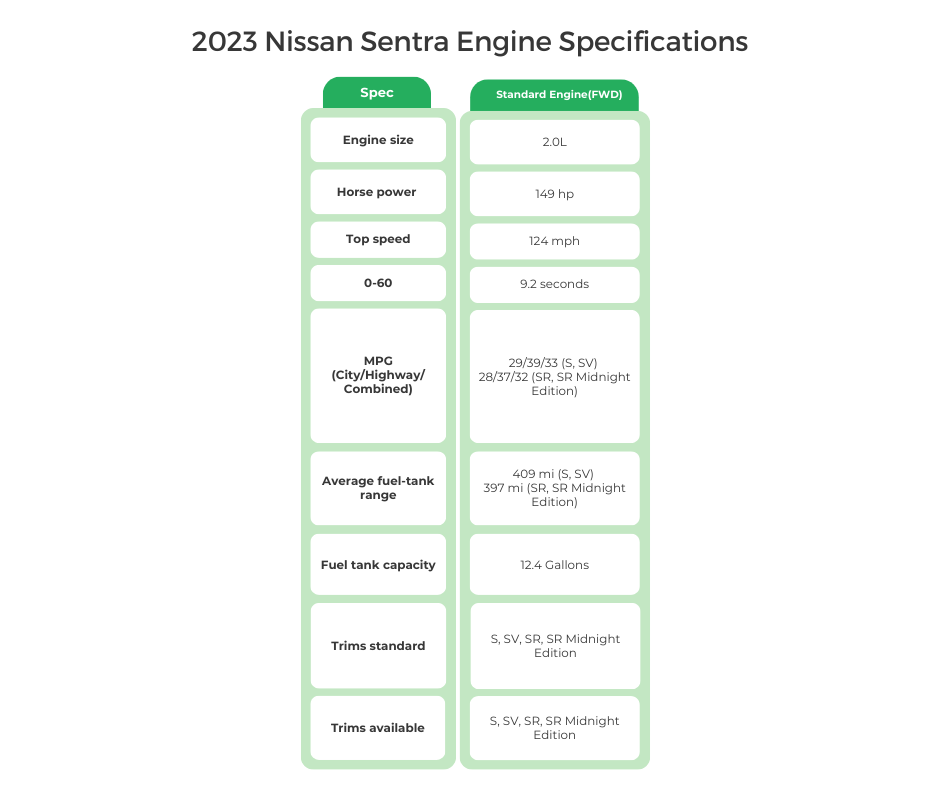
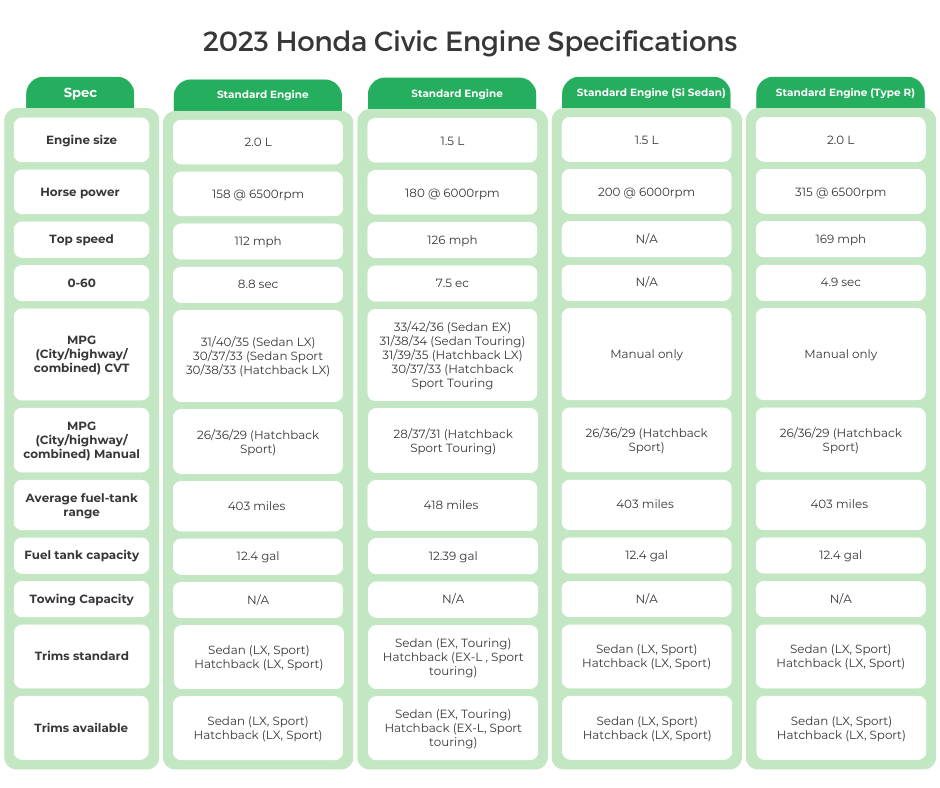
Transmission Options & Specifications:
Quick Take: The Sentra is a driving appliance, and the Civic offers driving fun.
It’s a CVT party with the 2023 Sentra, which only offers this transmission and most of the 2023 Civic lineup. However, the Civic offers the analog fun of a 6-speed manual transmission. In all cases, power is routed to the front wheels with no option for all-wheel drive on either car.
Curious about the inner workings of the belt-and-pulley continuously variable transmission? Check out our Tech Talk section below for more information.
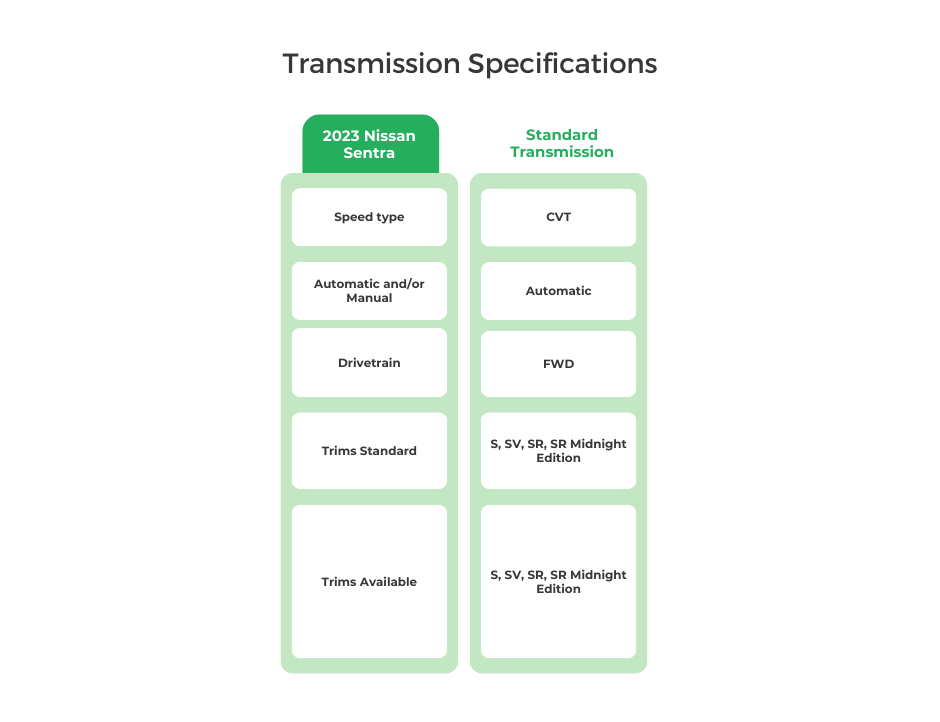

TECH TALK: CVTs
A continuously variable transmission (CVT) does not use gears like a typical automatic transmission. Instead, it has two pulleys connected by a belt. One pulley connects to the engine, and the other connects to the wheels. The belt transfers the power between the pulleys. This setup allows the pulleys to continuously change positions as needed. The CVT automatically adjusts the pulleys as required, providing smooth and efficient power delivery.
An electronic continuously variable transmission (eCVT) uses electronic controls and electric motors to vary gear ratios instead of a belt and pulley system. Unlike a regular CVT, an eCVT has no physical pulleys or belts—the gear ratio is adjusted seamlessly by controlling the speeds of electric motors and generators. This electronic control allows faster, smoother gear ratio changes compared to a traditional CVT. An eCVT also provides more flexibility, needing less space and having fewer moving parts.
Wheel Drive:
Quick Take: Find a good set of winter tires and beware of torque steer.
It’s a FWD-only affair with both the 2023 Nissan Sentra and Honda Civic. This is typical for the compact car class, though the Subaru Impreza bucks the trend with standard AWD. If you live in snowy climes and are concerned, just slap on a decent set of winter tires and you won’t miss AWD.
Another note here is torque steer, the slightly terrifying sensation of the steering wheel trying to jump free of your hands while accelerating hard in a FWD car. On the Sentra and entry-level Civics, this isn’t much of a concern given the relatively small power output figures.
However, the Civic Type R is another story. Fortunately, Honda’s engineering wizards created what they call a Dual Axis Strut to counteract this phenomenon rather than bolt on heavy AWD running gear.
| 2023 Nissan Sentra Wheel Drive | FWD | AWD | RWD |
| S | S | ||
| SV | S | ||
| SR | S | ||
| SR Midnight Edition | S |
| 2023 Honda Civic Standard | FWD | AWD | RWD |
| Sedan LX | S | ||
| Sedan Sport | S | ||
| Sedan EX | S | ||
| Sedan Touring | S | ||
| Hatchback LX | S | ||
| Hatchback Sport | S | ||
| Hatchback EX-L | S | ||
| Hatchback Sport Touring | S | ||
| Si Sedan | S | ||
| Type R | S |
S = Standard
U = Available in upgrade
E= electric on-demand AWD
D= AWD with rear driveline disconnect
Safety:
Quick Take: Both cars score highly in safety testing, but the Civic does marginally better and offers more advanced driver aids.
NHTSA Safety Ratings:
As you can see below, the 2023 Sentra and Civic earn 5 stars from the NHTSA in the overall, side crash, and rollover categories with 4 stars in the frontal crash protocol. But, digging deeper reveals that within those 4-star frontal crash ratings, the Civic fares better.
Both cars have 5 stars for frontal crash testing on the driver’s side, but the Civic earns 4 stars for the front passenger side crash test, while the Sentra earns 3 stars here.

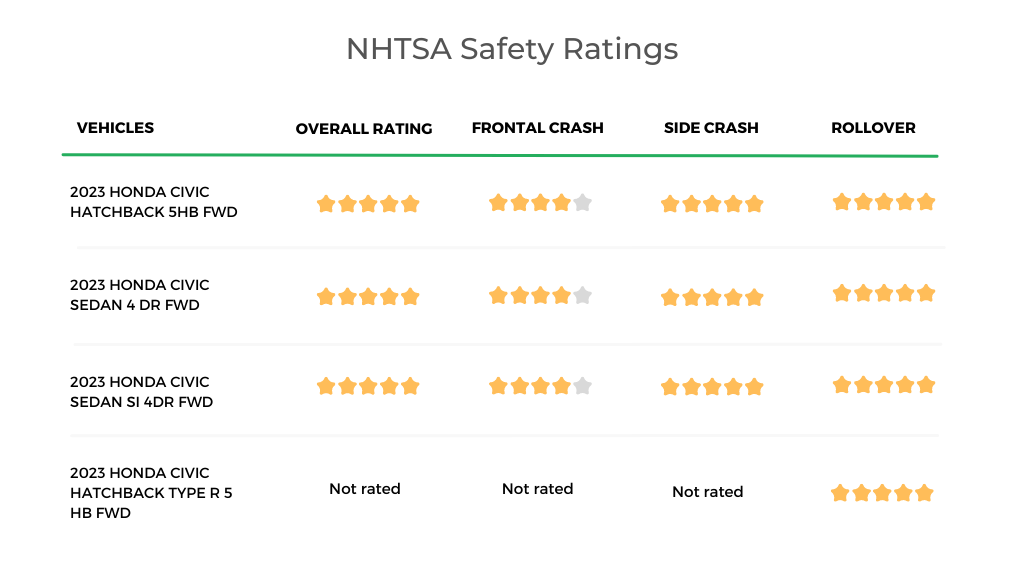
IIHS Awards:
Like with NHTSA safety testing, the 2023 Nissan Sentra and Honda Civic perform equally well in IIHS testing, a test that adds protocols for roof strength, head restraints, seats, headlights, and automatic emergency braking.
As you can see, they are both Top Safety Picks. However, going deeper reveals a slight safety advantage for the Civic. Across the battery of IIHS test protocols, the Civic earns nothing lower than an Acceptable rating, which applies to the updated moderate overlap front test.
But the Sentra is rated Poor for this test, which is the lowest possible IIHS test score. So, again, these cars are both very safe in crash testing, but the Civic is objectively safer.
| IIHS Award | Tested Vehicle | ||
| 2023 Nissan Sentra | Small Car/ 4-Door Sedan | 2022 TOP SAFETY PICK |
2020 Nissan Sentra SV 4-Door |
| 2023 Honda Civic | SMALL CAR / 4-DOOR SEDAN | 2023 TOP SAFETY PICK | 2022 Honda Civic 1.5T Touring 4-door |
| SMALL CAR / 4-DOOR HATCHBACK | 2023 TOP SAFETY PICK | 2022 Honda Civic 1.5T Touring 4-door | |
Airbags & Head Restraints:
Often taken for granted in modern vehicles, the hidden airbag remains an extremely effective safety device. Both the 2023 Sentra and Civic make good use of them by fitting 10 airbags around the cabin. This includes dual front, dual front and rear side, dual front knee, and full curtain airbags.
Overhead airbags, a relatively new technology, aim to protect occupants’ heads during a collision and are not offered in either the Sentra or Civic. You also won’t find active head restraints, which are designed to reduce whiplash, in either of these compact cars as it is more common in the luxury market.
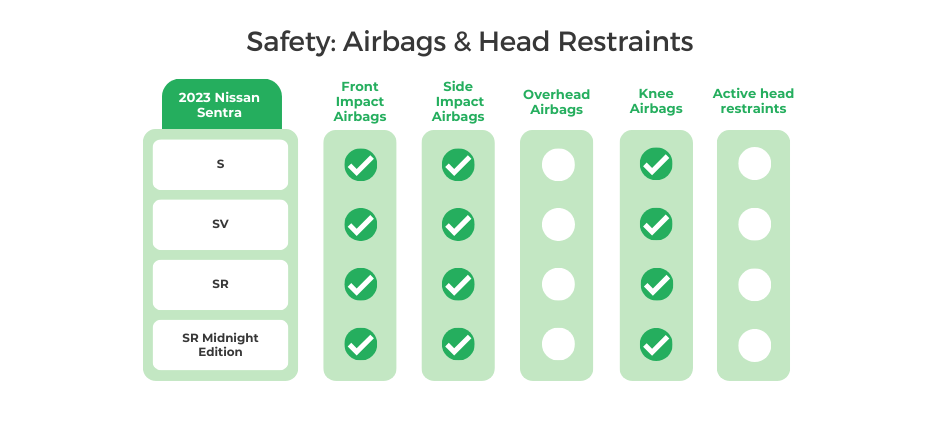
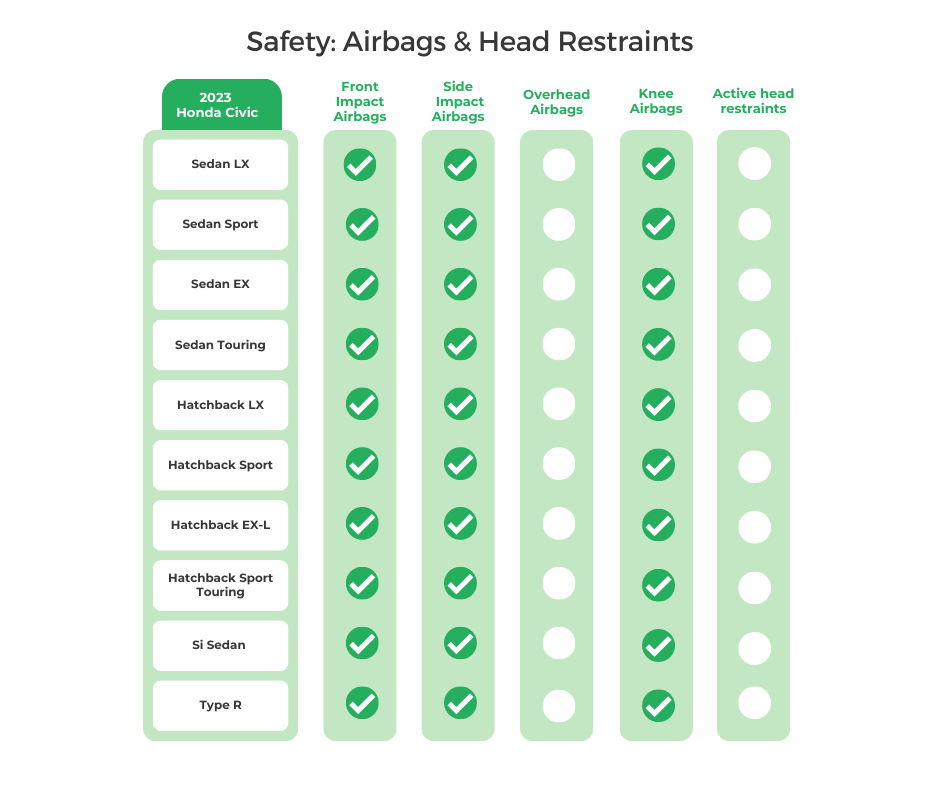
Semi-Autonomous Driving:
As semi-autonomous driving technology continues to permeate the automotive industry, the 2023 Nissan Sentra and Honda Civic continue to add these systems to their respective rosters of content. However, it’s the Civic that has a more robust offering.
In the Sentra, automatic emergency braking, brake assist, electronic brakeforce distribution, and rear automatic braking are all lineup standard features. The same is true of the Civic, but it also includes continuous assistive steering, corrective steering, and adaptive cruise control on all models.
That latter system differs from the Sentra’s traditional cruise control by managing vehicle speed and distance from preceding vehicles automatically.

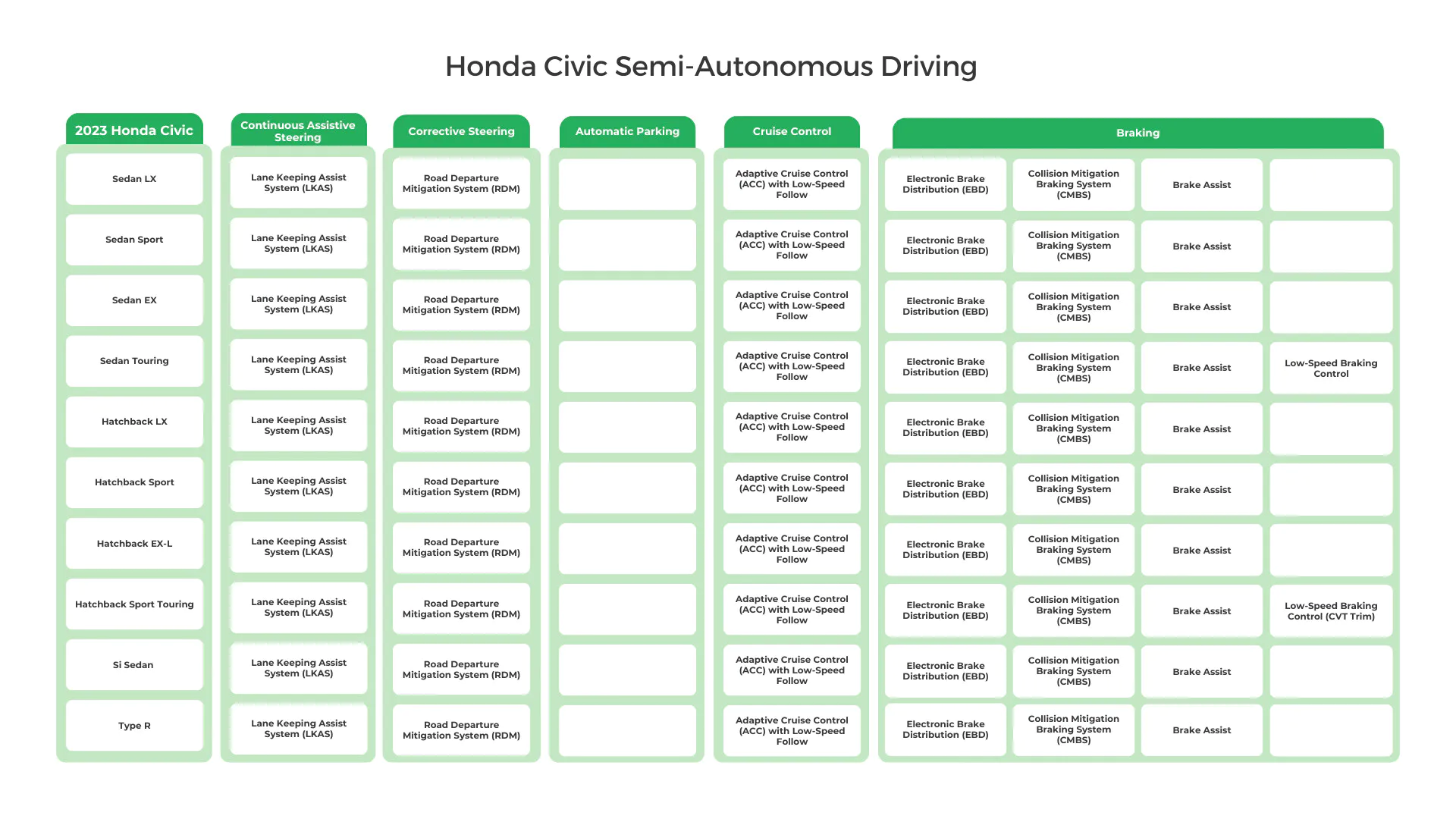
Driver Warning Systems & Telematics:
Within the category of advanced driver-assistance systems (ADAS) are driver warning systems and telematics, both of which can be found on a new Sentra and Civic. In the Sentra, standard ADAS consists of lane departure warning, forward collision warning with pedestrian detection, blind-spot monitoring (BSM) with rear cross-traffic alert (RCTA), and a driver attention monitor.
Honda largely mirrors Nissan here but BSM and RCTA are optional on the Civic, while traffic sign recognition is standard. Both cars offer a telematics system on certain models, but neither can be had with intersection turn assistance, safe exit assist, or a rear occupant alert.


Road Visibility Features:
Mostly gone from modern cars are halogen headlamps, replaced by the crisp and bright beams of LEDs. This type of headlight makes a world of difference with nighttime visibility and is standard only on the 2023 Civic versus the Sentra on which it is available.
Automatic high beams, a system that turns your high beams on and off for you, are standard on both cars as is a backup camera. Neither the Sentra nor the Civic offers a head-up display or adaptive headlights, but the Civic does offer rain-sensing wipers versus the Sentra, which does not.
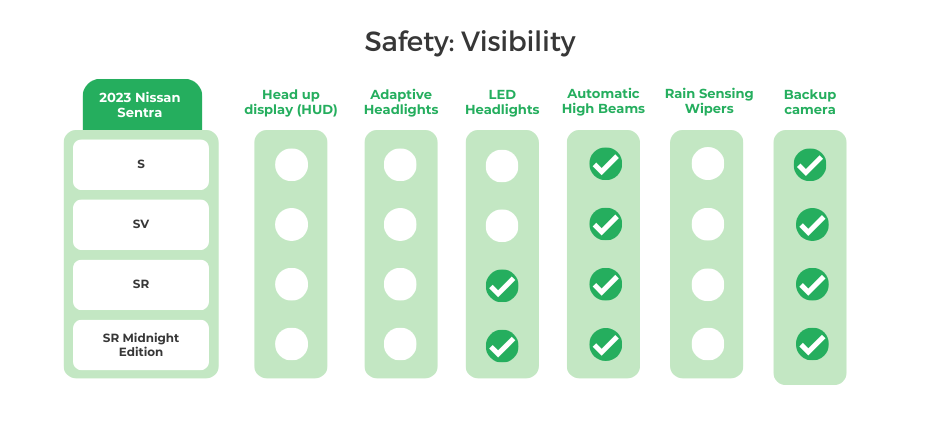
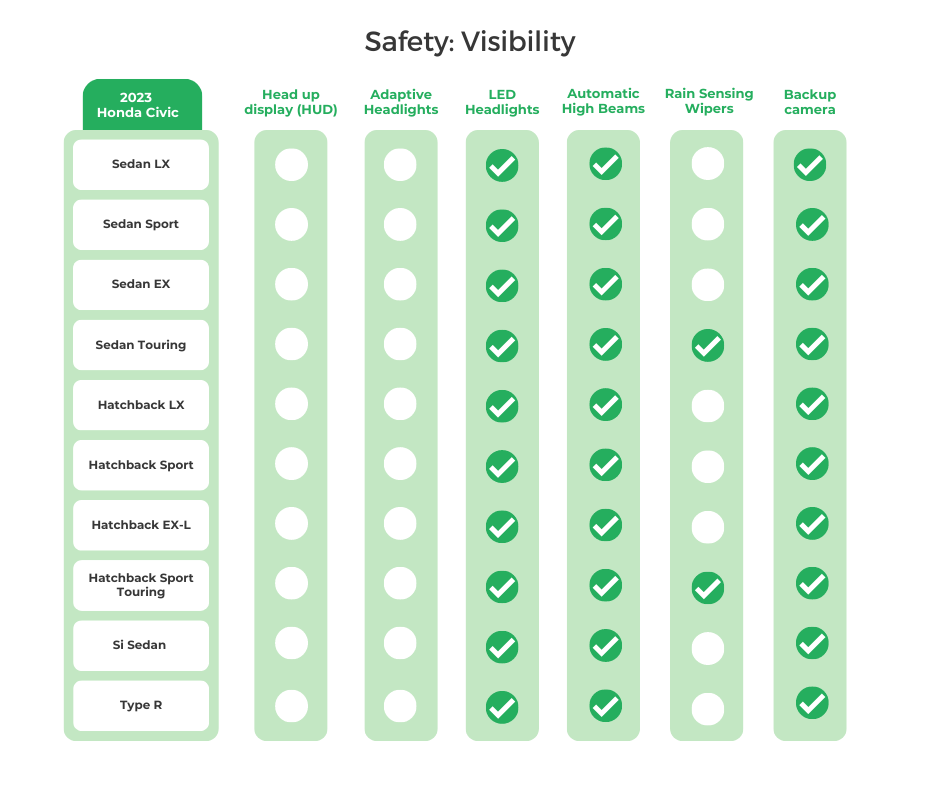
Interior:
Quick Take: You’ll find a similar lineup of noteworthy cabin features in the Sentra and Civic, but a larger overall space in the Honda.
Interior Features:
The “must have’ Apple CarPlay and Android Auto systems, which mirror your smartphone screen onto a car’s infotainment display, are both standard on the 2023 Sentra and Civic. Heated seats are unfortunately not standard, though the Nissan and Honda do offer them.
Something you will not find on these cars is a heated seat subscription. Not sure what that means? You’re not alone, but this growing “Features On Demand” marketplace in which owners only pay for features when they need them is set to take off according to McKinsey, so you may want to get familiar with the concept.
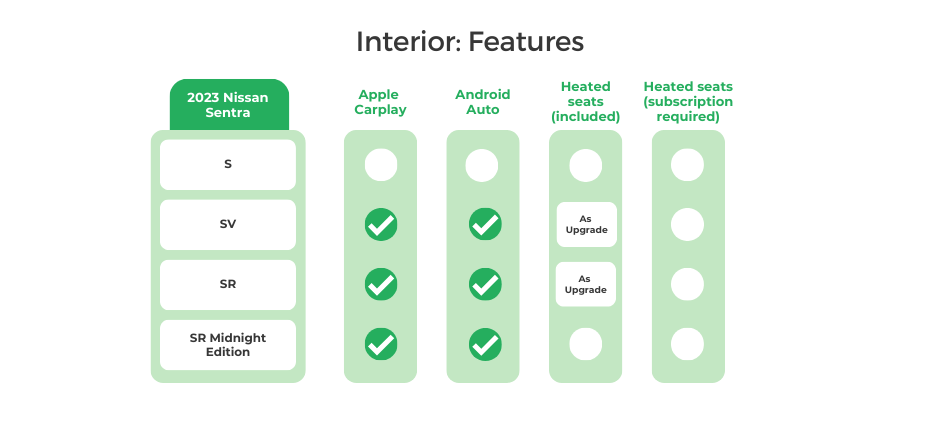
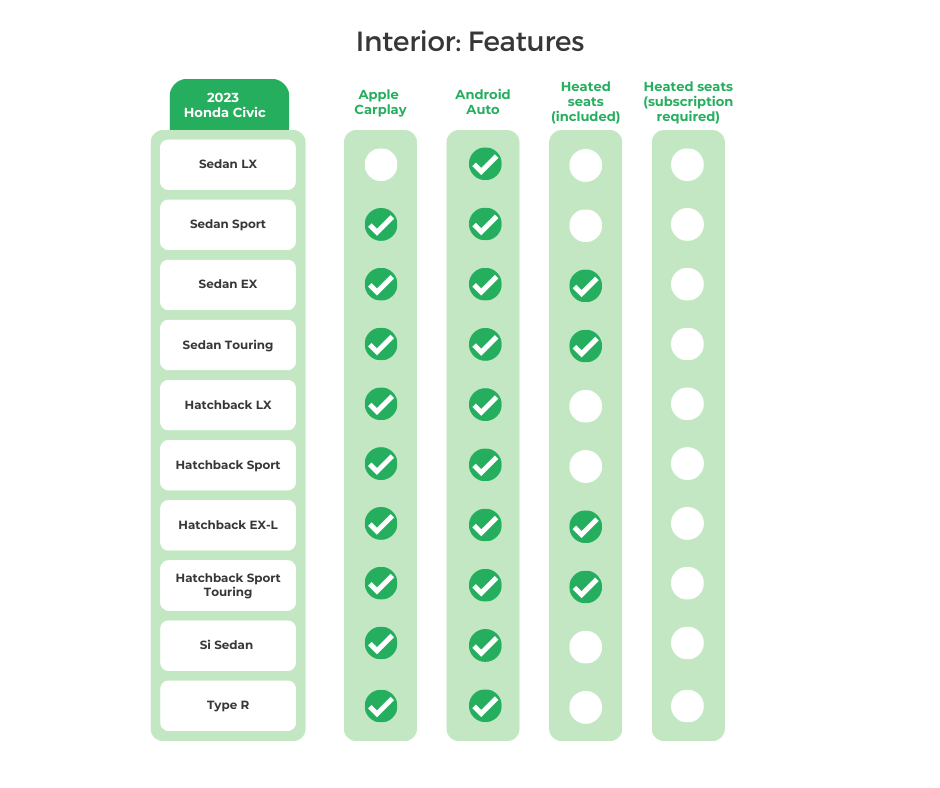
Interior Dimensions:
These two compact cars, the 2023 Sentra and Civic, both technically seat 5 people, but you might be considered rude for trying to stuff more than 4 adults in either car. If you did, the extra 4 inches of rear hiproom in the Sentra would surely be appreciated in some cases, but taller folk would likely prefer the extra 3 inches of rear legroom in the Civic.
Trunk space for the Sentra and Civic sedan is within half a cubic foot of total volume, but the Civic hatchback predictably dominates this metric with 24.5 cu. ft. of storage space versus 14.3 in the Sentra. Overall, the Civic has a larger cabin that offers 3 extra cubes of passenger volume versus the Sentra.
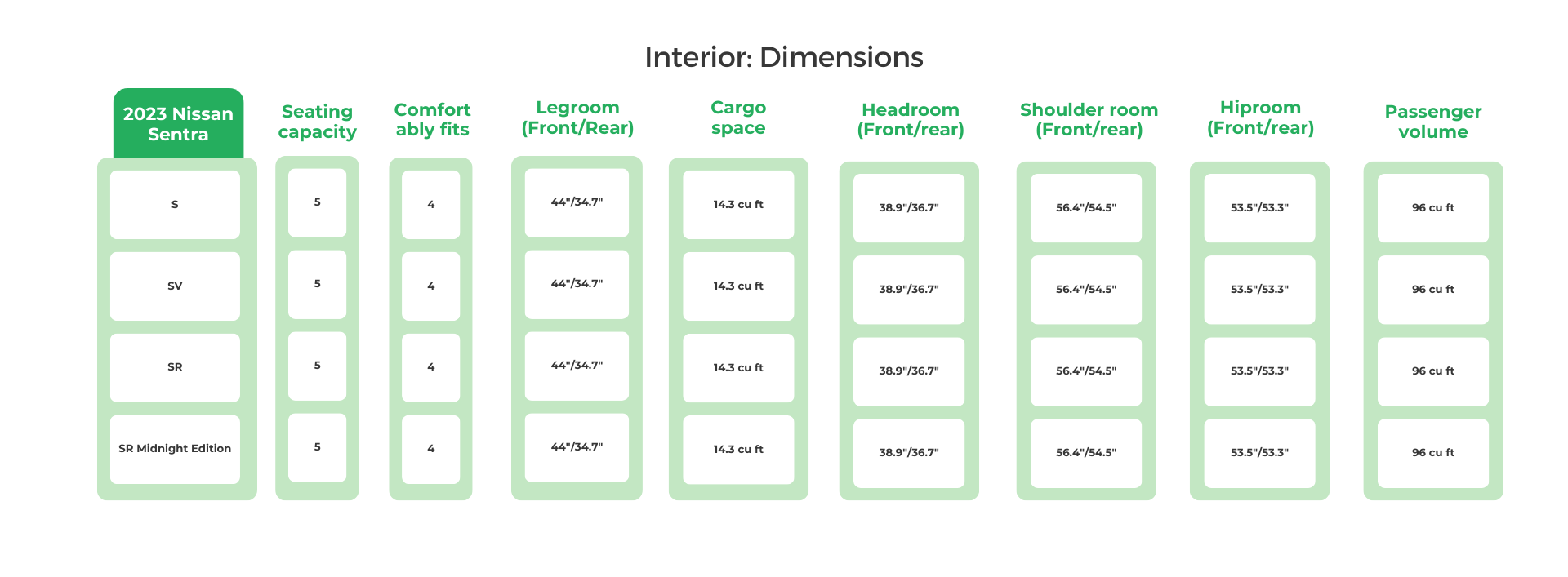
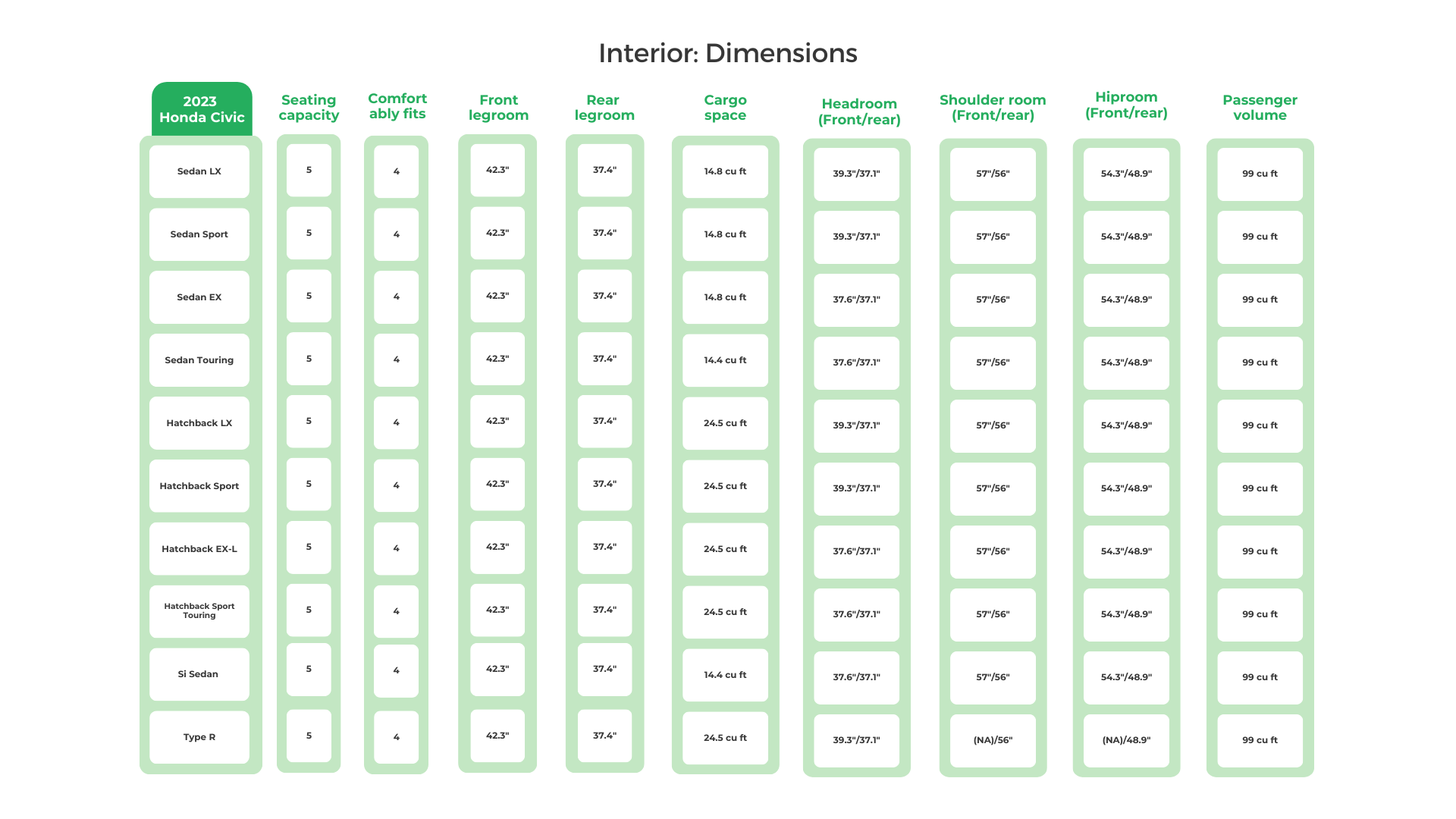
Exterior:
Quick Take: The latest Sentra and Civic stack up closely in exterior measurements, but the Civic takes the style win.
Exterior Features:
Showing the econobox roots of both of these cars, 16” steel wheels and hubcaps are the base setup for the 2023 Sentra and Civic. Moving through the trim ladder, however, opens up size 17 and 18 rims with available black finishes on both cars.
Only the Honda Civic can be fitted with big 19” rims, but that requires the mighty Type R variant, a model that also boasts a giant rear spoiler for more visual punch and downforce, of course.
Both the Sentra and Civic can be painted in the usual shades of black, gray, white, blue, and red. But if you need more style points, check out the two-tone Monarch Orange and black finish on the Sentra or Smokey Mauve Pearl – AKA purple – on the Civic.
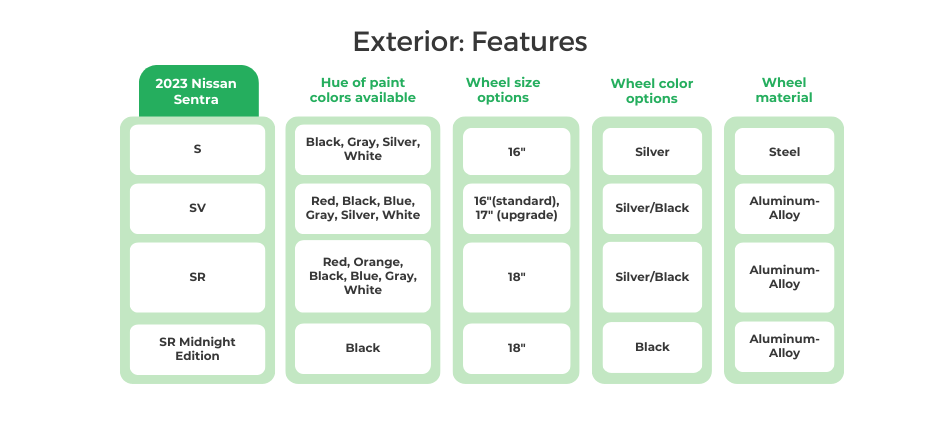

Exterior Dimensions:
Whether you call the Sentra and Civic compact or midsize, the fact remains that these cars have very similar footprints. A 2023 Sentra is about 1” shorter, a half-inch wider, and roughly 1” taller than its Civic counterpart.
Interestingly, the Sentra is close to 4” longer than a hatchback Civic, and yet the inherent practicality of this body style still delivers far more cargo space as discussed earlier. Though this may not be on most owners’ radar, the Sentra and Civic both tip the scales around the 3,000-pound mark.
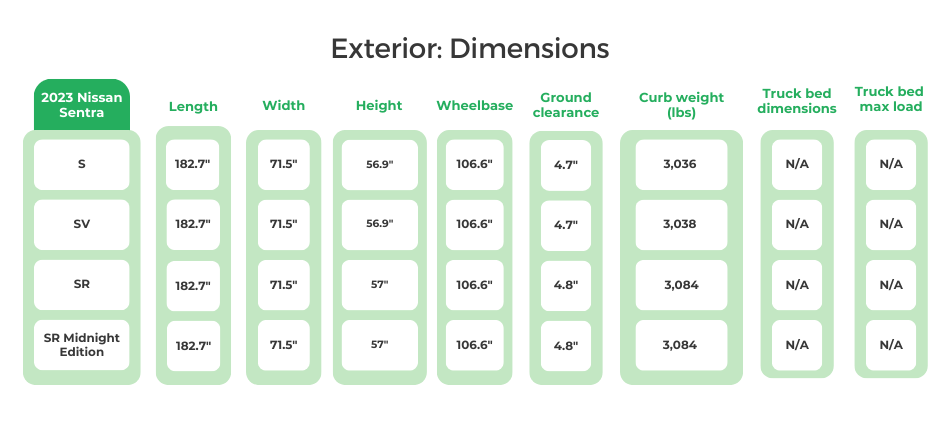
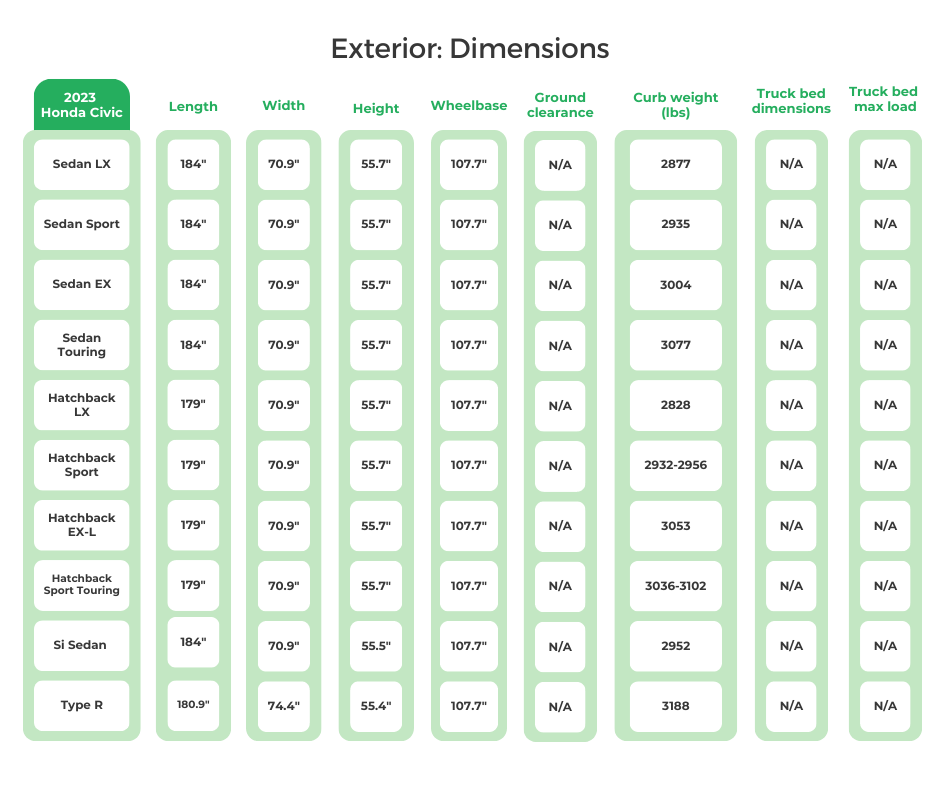
Warranty:
Quick Take: Basic and powertrain warranty coverage is identical here, but only Honda includes complimentary maintenance.
The industry average 3 years or 36,000 miles of basic warranty coverage and 5 years or 60,000 miles of powertrain coverage apply to a new Nissan Sentra and Honda Civic. Both also include 3 years of roadside assistance, but only the Civic comes with 2 years of complimentary maintenance.
As of this writing, the 2023 Nissan Sentra has no outstanding recalls, while the 2023 Civic has 2 open recalls, including one for an incorrectly assembled steering rack.
| 2023 Nissan Sentra Factory Warranty Coverage: | 2023 Honda Civic Factory Warranty Coverage: | |
| Basic warranty: | 36 months/36,000 miles | 36 months/36,000 miles |
| Powertrain warranty: | 60 months/60,000 miles | 60 months/60,000 miles |
| Corrosion perforation warranty: | 60 months/unlimited miles | 60 months/unlimited miles |
| Air conditioning warranty: | 12 months/unlimited miles | 24 months/24,000 miles |
| Battery warranty: | 24 months | 100 months/unlimited miles |
| Emissions warranty: | Federal: 36 month/36,000 miles (defect), 24 months/24,000 miles (performance)California: 36 months/50,000 miles (defect), 36 months/50,000 miles (performance) | 36 months/36,000 miles96 months/80,000 miles on some parts |
| Roadside assistance coverage: | 36 months/36,000 miles | 36 months/36,000 miles |
| Total unique recalls: | 0 | 2 |
Methodology
- Compare two vehicles, the Nissan Sentra and the Honda Civic, and provide a comprehensive analysis.
- Gather relevant information and data on both vehicles from reliable sources, such as manufacturer specifications, expert reviews, customer feedback, industry reports, and data sources like manufacturer websites, FIXD App, Kelley Blue Book, FuelEconomy.gov, and NHTSA.
- Collect data on various aspects, including performance, safety features, fuel efficiency, maintenance costs, reliability, owner satisfaction, and market value.
- Identify the key criteria that will be used to evaluate and compare the two vehicles.
- Ensure the criteria cover both objective factors (such as performance metrics, safety ratings, and fuel efficiency) and subjective factors (such as owner satisfaction, comfort, and features).
- Assess the performance of both vehicles based on factors such as acceleration, handling, braking, and overall driving experience.
- Compare engine options, horsepower, torque, transmission options, and any unique performance features.
- Examine the safety features and ratings of both vehicles.
- Evaluate crash test ratings, advanced driver assistance systems (ADAS), active and passive safety features, and any notable recalls or known issues related to safety.
- Consider both NHTSA safety ratings and IIHS awards for a comprehensive safety assessment.
- Analyze the fuel economy of both vehicles based on EPA mileage estimates.
- Compare their MPG ratings, average full-tank range, and any significant differences in fuel efficiency.
- Compare the features and technologies offered by both vehicles.
- Highlight any notable differences in terms of infotainment systems, connectivity options, driver assistance features, interior quality, and available upgrades.
- Summarize the findings of the comparison, highlighting the positives and negatives of each vehicle.
- Provide a fair and balanced recommendation based on the comparison, considering factors such as budget, personal preferences, specific needs of the buyer, and the comprehensive analysis conducted.
Sources:
- Fuel Economy: Mileage-per-gallon estimates according to the EPA MPG on Fueleconomy.gov.
- Annual Maintenance/Repairs: Upkeep expenses as published by Edmunds.com.
- Safety Ratings: Crash test data collected and reported by NHTSA. We average all ratings for each year to come up with a simplified, average safety score. This makes it easier to look at on a graph. We also collected IIHS Awards for this article.
- Vehicle Features: Most or all information gathered on vehicle features were from the manufacturer websites, in this case NissanUSA.com and Automobiles.Honda.com

Niel Stender grew up doing replacement work on his old Cherokee and sweet Mitsubishi Starion, which led to a degree in mechanical engineering and a job at Ford as a vehicle dynamics engineer. His writing infuses that automotive background with sales and marketing experience. Writing about cars for close to a decade now, he enjoys digging into some of the more technical mechanical systems under the hood and throughout a vehicle.















